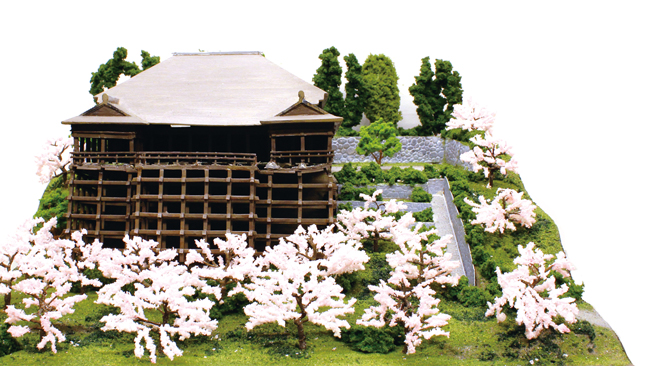
当たり前に日本人として生きてきた。でも海外に出てから、日本について何も知らないことに気が付いた。そこで、日本が世界に誇る世界遺産について建立年順に勉強しようと思う。興味がある人も、そうでない人も、しばしお付き合いを。
I’ve lived my whole life as a Japanese person, but when I went overseas I realised I know practically nothing about Japan. So now I’m learning about Japan’s World Heritage Sites, from oldest to newest. Those who are interested, and even those who are not, come along for the ride.

撮影協力 / メルボルン総領事館 Thanks to the Consulate-General of Japan, Melbourne
○○○○○ 清水寺 清栄峻茂の中に佇む四季折々の魅力が溢れる寺院 ○○○○○
日本の都市の中でも、世界的に知名度の高い京都は、平安京が建設された794年から江戸時代までの約1,000年間『平安の都』として、政治・経済・文化などの中心的な役割を果たし、独自の繁栄を築いてきました。平安時代から江戸時代までの各時代を代表する建築・庭園様式、文化的背景を今に伝えていること、日本の建築・庭園様式の発展に大きな影響を及ぼしたことが評価され、『古都京都の文化財』として1994年に、京都府京都市、宇治市、滋賀県大津市に点在する17の建造物が世界文化遺産に登録されました。登録されているのは、上賀茂(かみがも)神社、下鴨(しもがも)神社、東寺(とうじ)、清水寺(きよみずでら)、延暦寺(えんりゃくじ)、醍醐寺(だいごじ)、仁和寺(にんなじ)、平等院(びょうどういん)、宇治上(うじがみ)神社、高山寺(こうざんじ)、西芳寺(さいほうじ)、天龍寺 (てんりゅうじ)、鹿苑寺(ろくおんじ)、慈照寺(じしょうじ)、龍安寺(りょうあんじ)、西本願寺(にしほんがんじ)、二条城(にじょうじょう)です。
今回はその中のひとつ、清水寺を紹介します。清水寺は、京都市東山区清水にある寺院で、北法相宗大本山。創建は平安京遷都よりも古く、778年に開山されました。始めは「北観音寺」と呼ばれていましたが、境内に湧き出る清水が観音信仰の黄金延命水として神聖化され、一般にも清めの水として「清水」が知られるようになり、後に名称を「清水寺」に改めました。清水寺の伽藍(がらん)は、記録に残るだけで9回の焼失を繰り返していますが、人々の信仰の力により、その都度、再建・復興を果たしてきました。ちなみに現在の伽藍は、1629年の大火災によって建物の殆んどが全焼したものの、徳川三代将軍 家光(いえみつ)の寄進により、わずか数年で再建されました。近年では2008年から2020年にかけて、貴重な建築を未来に残すため「平成の大改修」が行われました。
季節後ごと、桜、新緑、紅葉などが美しい13万平方メートルの境内には、名称の由来にまつわる音羽(おとわ)の滝、豪華絢爛な桃山様式の西門(さいもん)や三重塔のほか、多くの国宝・重要文化財に指定された建造物があります。子供の頃、京都に住む祖父母に連れられ、清水坂でなくお墓や竹林の横を通る山道を上って清水寺に行った記憶があります。 人通りも少なく店もない細い道でしたが、緑豊かで野鳥のさえずりを聞きながら楽しく歩き、安産祈願に訪れる人が多い子安塔(こやすのとう)に辿り付いたのを覚えています。また、善光寺堂(ぜんこうじどう)の手前にある「首ふり地蔵」や、縁結びで有名な地主神社の「恋占いの石」があるので、気になる人はお試しを。
清水寺といえば、京都市内が一望できる本堂の舞台。「清水の舞台から飛び降りたつもりで○○する!」という決意の言葉がありますが、これは本当に飛び降りた人々から生まれた言葉だとか。地上12m、4階建てビルに相当する清水の舞台からの飛び降りは、記録によると、江戸時代中期から明治維新直前の1864年までの間に、未遂を含めてなんと235件。なんでも清水の観音様に一心に祈って飛ぶと、命も助かり願いも叶うという迷信による、願掛けだったようです。ちなみに生存率は、約85%。最年長は80歳で、最年少は12歳! 両者共に、何を願ったか気になるところです。1872年に京都府が禁止令を出し、飛び降り防止用の竹矢来が組まれ、飛び降りがなくなりました。
次回は、古都京都の文化財のひとつである平等院を紹介します。
○○○Kiyomizu-dera: a beautiful temple in every season○○○
Kyoto, one of Japan’s more famous cities, was a flourishing centre of politics, economics and culture for a thousand years after it was built as the Heian capital in 794. The ‘Historic Monuments of Ancient Kyoto’, 17 structures dotted through Kyoto, Uji and Otsu cities, became World Heritage listed in 1994; and they are highly valued for representing influential styles in Japanese architecture and gardens from the Heian to the Edo period. These 17 properties are: Kamigamo Shrine, Shimogamo Shrine, To-ji, Kiyomizu-dera, Enryaku-ji, Daigo-ji, Ninna-ji, Byodo-in, Ujigami Shrine, Kozan-ji, Saiho-ji, Tenryu-ji, Rokuon-ji, Jisho-ji, Ryoan-ji, Nishi Hongan-ji, and Nijo Castle.
This month we cover one of these monuments, Kiyomizu-dera. Located in Higashiyama-ku in Kyoto, Kiyomizu-dera is the head temple of the Kitahosso sect of Buddhism. It was founded in 778, before the capital was relocated to Kyoto. At first it was called ‘Kitakannon-ji’ (‘North Kannon Temple’), but the clear spring water in the grounds became consecrated as the ‘golden eternal water of Kannon’, and the shrine became famous for this ‘kiyomizu’ (‘clear water’). Later the name was officially changed to ‘Kiyomizu’ temple. The temple buildings have been destroyed by fire nine times, but thanks to strong religious devotion have been restored or reconstructed every time. Today’s buildings were nearly entirely destroyed in the fires of 1629 but were rebuilt in only a few years thanks to the contributions of shogun Tokugawa Iemitsu. In recent years, from 2008 to 2020, large-scale repairs was carried out in order to leave valuable architecture in the future.
The 130,000 square metre grounds are beautiful in each season either with cherry blossoms, new green growth, or autumn leaves. And there are many structures designated as national treasures or important cultural properties. These include Otowa Waterfall, where the clear water flows that gave the temple its name; the West Gate (‘Saimon’), built in gorgeous Momoyama period style; and the three-storey pagoda. I have a childhood memory of going to Kiyomizu-dera with my grandparents, who lived in Kyoto, not via Kiyomizu-zaka, but up a sloping path with bamboo and gravestones on either side. It was narrow, with few pedestrians and no shops, but I remember enjoying the lush greenery and the warbling of the birds before arriving at Koyasu-no-to, a pagoda visited by expectant parents to pray for an easy delivery. There is also the ‘Kubifuri Jizo’ at the front of Zenkoji-do Hall, as well as the ‘love stones’ and ‘en-musubi’ (‘knot-tying’) at Jishu Shrine, if you feel inclined to try some love-related fortune telling.
Another famous feature of Kiyomizu-dera is the stage of the main temple building, from which you can see all of Kyoto city. There is a Japanese expression ‘to jump off the stage at Kiyomizu’, which is equivalent to ‘take the plunge’ in English, but apparently the expression once had a literal meaning. According to records, from the mid-Edo period to just before the Meiji Restoration, there were 235 jumps or attempted jumps from the stage, which is 12m from the ground – as high as a four-storey building! There was a superstition that if you jumped off the stage while praying fervently to Kannon, your life would be saved and your prayers answered. Around 85% of people who jumped survived. The eldest was 80, and the youngest was 12! I keep wondering what those two were praying for... In 1872, Kyoto city banned the practice, and a bamboo enclosure was erected. This put an end to jumps from the stage.
Next time we introduce another of the ‘Historic Monuments of Ancient Kyoto’, Byodo-in.

